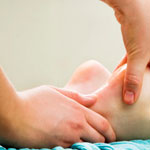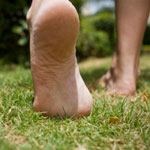Bunions
"Bunions" is a lay-persons description of a condition called Hallux Valgus. Hallux valgus describes the vastly altered alignment of the big toe which becomes severely angulated towards the lesser toes thus producing a classic diamond shaped forefoot. The massive protrusion on the inside of the foot at the base of the big toe ie the bunion,can be very painful as it becomes increasingly susceptible to shoe pressure. Over time, such pressure can result in a build up of corn or callous tissue over the bunion which invariably necessitates a visit to the podiatrist. In extreme circumstances severe pressure can result in ulceration of the bunion joint.
Treatment
While there may be some evidence to suggest that bunions are caused by wearing tight ill fitting shoes, this tends to be mainly discounted by the professional body. (Countless patients speak of having worn "the most sensible shoes throughout my child hood because my parents were so particular" but have still developed severe bunions).
The most common reason for the development of bunions is because of excessive pronation in some of the most important joints of the foot (mainly the sub talar joint). Pronation is a movement that takes place in three planes simultaneously and describes a structure that everts, abducts and dorsiflexes. In lay persons terms, if one was to apply this concept to the forefoot in a gait cycle, one would say that the forefoot was moving upwards and outwards and moving away from the mid line of the body. (The mid line being a line that would divide the body down the middle, starting from the middle of the forehead and ending midway between the feet). If, because of a number of possible biomechanical weakness's in the structure of the patients anatomy there is excessive torque in the forefoot when walking or running, that excessive torque and stress will result in a gradual change in the structure of that forefoot thus resulting in the classic bunion. A biomechanical examination of this patient is therefore critical in determining the underlying causes of the excessive pronation, which can thus be alleviated by the patient being prescribed orthotics (custom made insoles).
Such treatment could be described as a form of preventative health care designed to decelerate the process of the impending breakdown in the fore foot thus ensuring greater mobility and comfort in the long term.
Reconstructive forefoot surgery could be recommended by the podiatrist to correct this condition (ie the removal of the bony lump). However most podiatrists would consider this referral only in the most advanced conditions and would consider it as a last resort. (It should be stated here that many patients are not hampered by their bunions at all except to say that shoe fitting can be more difficult. They are not necessarily always painful).
For further information on bunion's or other conditions and services please call 01227 360940 / 01795 430020 / 07985014566 or send us an email info@hernebaychiropody.co.uk

These are synonomous to warts, except that they tend not to protrude beyond the level of the surrounding soft tissue.

This condition can generally fall into two categories; an involuted nail and an acute in growing toe nail.

A quick inspection of this foot will reveal a foot that has a low arch (or no arch) and a heel that turns outwards.

Our Services
Conditions Treated
- Plantar Fasciitis
- Verrucae
- All nail conditions (in growing, thick, fungal etc.)
- Diabetes
- Flat feet
- Plantar Fasciitis
- Verruca
- All nail conditions (in growing, thick, fungal etc.)
- Diabetes
- Flat feet
- Corns
- Callous (Hard skin)
- Bunions
- Hammer toes
- Blisters
- Bursae
- Rheumatoid arthritis
- Osteoarthritis
- Chilblains
- Mortons Neuroma
- Soft corns
- Cracked skin
- Circulatory diseases
- Achilles tendonitis
- Pronation
- Supination
- Tired / aching feet
- Foot strain
- Metatarsagia
Area we cover
Herne Bay Whitstable Canterbury Sturry - Blean Faversham - Westgate - Tankerton - Medway towns

